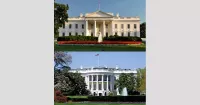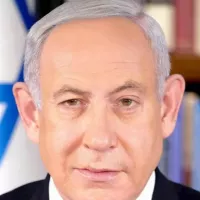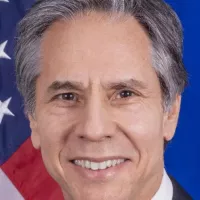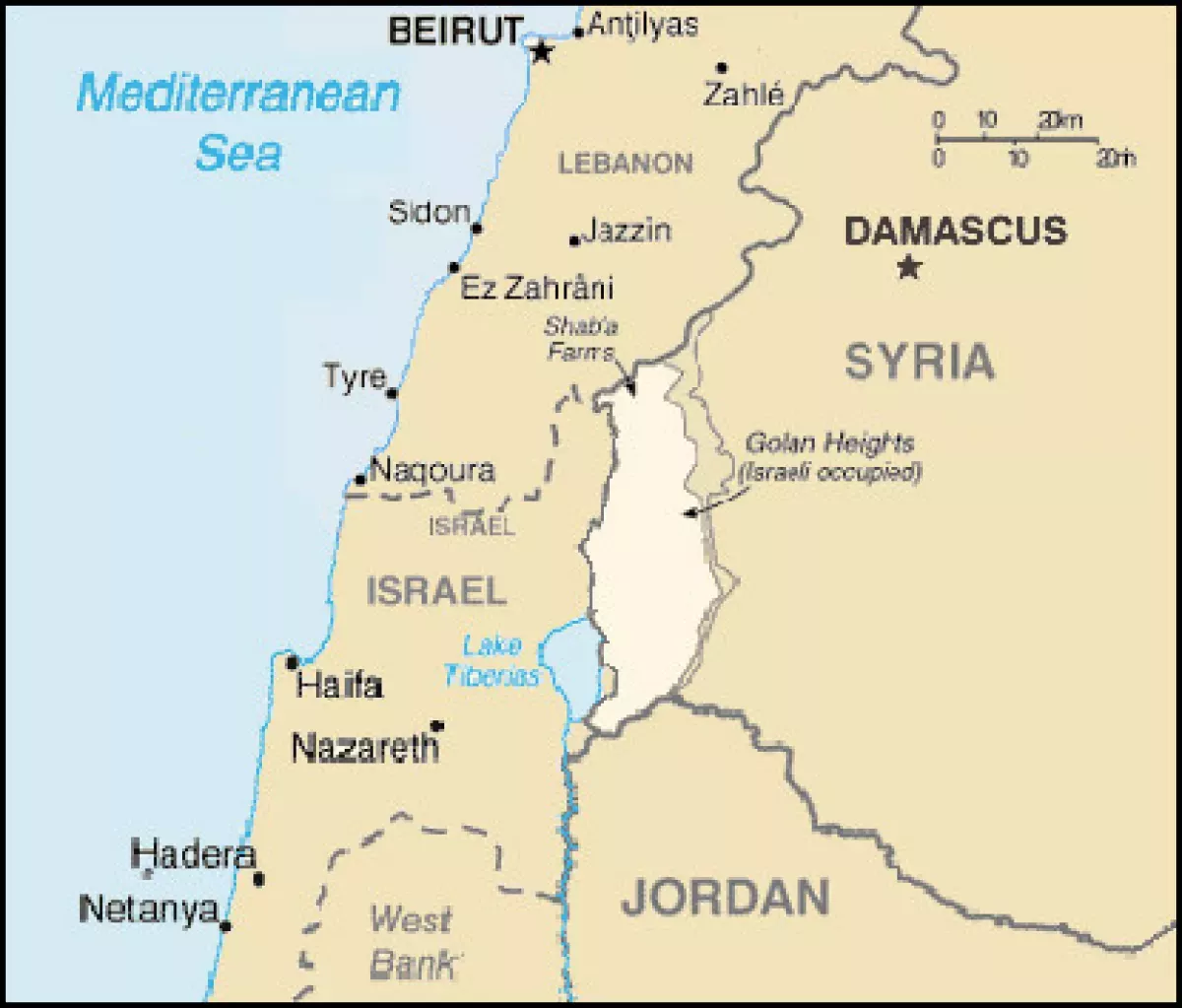The Golan Heights is a plateau bordered by the Yarmouk River, Sea of Galilee, Hula Valley, Anti-Lebanon mountains, and Wadi Raqqad. Two-thirds of the Golan Heights has been occupied by Israel since the 1967 Six-Day War and was effectively annexed in 1981. However, the international community rejects this annexation and recognizes the territory as Syrian under Israeli occupation.
1920: Franco-British Agreement Places Part of Golan Under British Control
In 1920, the Franco-British agreement temporarily placed a portion of the Golan Heights under British administration.
1923: Golan Triangle Ceded to French Mandate, Land Exchange with Palestine
In 1923, a triangular area in the northwestern Golan region, encompassing the towns of Banias, Quneitra, and the northern tip of the Sea of Galilee, which was initially part of the British Palestine Mandate, was transferred to the French Mandate in Syria. In exchange for this territory, Palestine received land areas in Syria and Lebanon, and the entirety of the Sea of Galilee, previously bordering Syria, was incorporated into Palestine.
1923: Boundary Demarcation Based on Water Resources
The 1923 boundary between British Mandatory Palestine and the French Mandate of Syria was determined based on water resources. It ensured that the entirety of the Sea of Galilee, including a narrow strip of beach along its northeastern shore, remained within Mandatory Palestine. The boundary north of the Sea of Galilee to Lake Hula was drawn to keep the upper Jordan River entirely within Mandatory Palestine. The British also obtained a small section of land along the Yarmouk River, extending to present-day Hamat Gader.
1948: Shifting Terminology and Territorial Claims
Before 1948, the area encompassing the Golan Heights was referred to as Mandatory Palestine. However, the terminology and territorial claims surrounding this region underwent significant changes following the events of 1948.
July 1949: 1949 Armistice Agreement Establishes Demilitarized Zone
In July 1949, the Armistice Agreement between Israel and Syria resulted in the creation of a demilitarized zone. Syrian forces withdrew east of the 1923 Palestine-Syria boundary, while Israeli forces were prohibited from entering the evacuated areas.
April 1967: Escalation on the Golan Heights
Tensions further escalated in April 1967 when Israel, in response to heavy shelling from Syrian positions on the Golan Heights, shot down six Syrian MiG fighter jets and issued a warning against future attacks.
June 4, 1967: "Line of June 4, 1967" Represents Disposition of Forces
The "line of June 4, 1967" represented the specific deployment of forces immediately preceding the Six-Day War, reflecting the evolving tactical situation and attempts by both Israel and Syria to capitalize on the territorial uncertainties arising from the 1949 agreement.
June 1967: Israeli Cabinet's Conditional Offer
Despite capturing the Golan Heights, the Israeli cabinet voted to return the territory to Syria in exchange for a peace agreement, highlighting their initial willingness to negotiate. However, this offer was withdrawn after the Khartoum Resolution in September 1967.
June 1967: Six-Day War and the Capture of the Golan Heights
Following the outbreak of the Six-Day War in June 1967, Syria intensified its shelling, prompting an Israeli offensive that resulted in the capture of the Golan Heights on June 9-10. The new ceasefire line was designated as the Purple Line.
July 1967: Beginnings of Israeli Settlement
Soon after the Six-Day War, Israeli settlements began to appear in the Golan Heights, with Merom Golan established in July 1967, marking the start of an ongoing process of settlement expansion.
September 1967: Khartoum Resolution and Rejection of Peace
The Khartoum Resolution of September 1967, issued by Arab League nations, rejected peace, recognition, or negotiations with Israel, effectively nullifying Israel's offer to return the Golan Heights in exchange for peace.
October 1967: Initial Request for Golan Heights Settlement Plan
In October 1967, the initial request for an agricultural settlement plan for the Golan Heights was made.
1967: Syrian Displacement During Six-Day War
During the 1967 Six-Day War, between 80,000 and 130,000 Syrians fled or were driven from the Golan Heights, while around 7,000 remained in the Israeli-held territory.
1967: Syria Demands 1967 Frontier for Golan Heights Return
During the 1999-2000 peace talks, Syria insisted on the 1967 border for the return of the Golan Heights. This demand was based on their claim that the pre-1948 border was imposed by colonial powers.
1967: Israeli Provocations and Border Incidents
Former Israeli defense minister Moshe Dayan claimed in 1976 that Israel had provoked over 80% of the border incidents with Syria leading up to the 1967 war, often using tactics like sending tractors to plow in demilitarized areas, which elicited Syrian responses.
1967: Border Clashes and Escalating Tensions
In the lead-up to the 1967 war, border clashes intensified. Israeli incursions into the demilitarized zone were met with Syrian fire, often targeting Israeli settlements, further fueling tensions in the region.
1967: Existence of Three Distinct Lines Separating Syria and Former Palestine
Prior to 1967, three separate lines demarcated the boundary between Syria and the area previously known as Mandatory Palestine, contributing to the complexities of the dispute.
1967: Ghajar Village Divided by International Boundary
Prior to the 1967 war, Ghajar, an Alawite village, was located within Syria. However, after the war, it became divided by an international boundary.
1967: Druze Brides Allowed to Cross into Syria
Since 1967, Druze brides have been allowed to cross from the Israeli-occupied Golan Heights into Syria, although with the understanding that they may not be able to return.
1967: Syrian Demands and Israeli Withdrawal Considerations
Syria continued to demand a complete Israeli withdrawal to the 1967 borders, including a strip of land along the Sea of Galilee that Syria had captured during the 1948-49 Arab-Israeli War. Israel, in turn, considered withdrawal from the Golan Heights in exchange for normalized relations with Syria, but only if its security concerns were addressed.
1967: Disagreement Over Sea of Galilee Access Stalls Peace Talks
The 1999-2000 Israel-Syria peace talks faltered due to conflicting claims over the Sea of Galilee. While the difference between the proposed borders was minimal, the 1967 line would grant Syria access to this crucial water resource, which Israel aimed to retain.
1968: Excavations Begin at Rujm el-Hiri
Excavations at the ancient stone monument of Rujm el-Hiri, located in the Golan Heights, began in 1968. Archaeologists believe the site may have served as a ritual center connected to a cult of the dead.
1970: Expansion of Israeli Settlements
By 1970, twelve Israeli settlements had been established in the Golan Heights, indicating a growing Israeli presence and commitment to the captured territory.
1971: Formal Approval of the Golan Heights Settlement Plan
The settlement plan for the Golan Heights, initiated in October 1967, was formally approved in 1971.
1972: Golan Heights Deemed Suitable for Winemaking
During a visit to the Golan Heights in 1972, Professor Cornelius Ough from the University of California, Davis, identified the region as highly suitable for cultivating wine grapes.
1973: Dayan's Claims and the 1973 War
Dayan's claims about Israel's role in provoking border incidents with Syria leading up to the 1967 war emerged after his forced resignation as Defense Minister in 1973, following criticism of his handling of the Yom Kippur War.
1973: Yom Kippur War and Syrian Advance
During the 1973 Yom Kippur War, Syrian forces managed to overrun a significant portion of the southern Golan Heights, demonstrating their continued military capability and determination to reclaim the lost territory. However, Israel ultimately repelled the Syrian advance.
1973: Syrian Controlled Golan Heights
Following the 1973 ceasefire line, the Syrian controlled part of the Golan Heights encompassed an area of 600 square kilometers and included over 40 towns and villages.
1973: Partial Return of Territory and Demilitarized Zone
In the aftermath of the 1973 Yom Kippur War, Israel agreed to return approximately 5% of the Golan Heights to Syrian civilian control. This area was integrated into a demilitarized zone along the ceasefire line and placed under the supervision of the United Nations Disengagement Observer Force (UNDOF).
1973: Legacy of Landmines in the Golan Heights
Landmines planted by the Syrian army before 1973 continue to pose a significant threat in the Golan Heights.
1974: Ceasefire Agreement and Demilitarized Zone
In 1974, Israel and Syria signed a ceasefire agreement, solidifying Israel's control over most of the Golan Heights. The agreement established a demilitarized zone along the frontier and imposed limitations on military deployments within a 25-kilometer radius.
1974: Quneitra Returned to Syrian Control
In 1974, Quneitra was handed back to Syrian civil control as per the 1974 Disengagement Agreement. However, the Israelis had destroyed much of the city with dynamite and bulldozers before withdrawing.
1974: Syrian Controlled Golan Heights
The 1974 ceasefire agreement left a portion of the Golan Heights (30%) under Syrian control. This area, which Israel did not capture or from which it withdrew, is home to over 40 Syrian towns and villages.
1974: UNDOF Established to Supervise Ceasefire and Separation
The United Nations Disengagement Observer Force (UNDOF) was established in 1974 to oversee the implementation of the Agreement on Disengagement between Israel and Syria. UNDOF's mission includes maintaining the ceasefire and monitoring the area of separation, known as the UNDOF Zone.
1975: Return of the Demilitarized Zone and Reconstruction Efforts
Following the 1974 ceasefire, Israel returned a narrow demilitarized zone to Syrian control. This allowed some displaced residents to return and rebuild their lives with support from the Syrian government, with the exception of the city of Quneitra.
1976: First Vines Planted in Golan Heights
The first wine grape vines were planted in the Golan Heights in 1976, marking the beginning of a thriving wine industry in the region.
1976: Revision of the Golan Heights Settlement Plan
The settlement plan for the Golan Heights, which aimed to establish 34 settlements by 1995, was revised in 1976.
1980: Allon Plan and the Druze State Proposal
Israeli politician Yigal Allon proposed the establishment of a Druze state in Syria's Quneitra Governorate, encompassing the Israeli-held Golan Heights, as part of the Allon Plan. However, Allon's death in 1980 prevented the plan's realization.
December 1981: Golan Heights Law and International Condemnation
On December 14, 1981, Israel passed the Golan Heights Law, effectively annexing the territory. This move was met with international condemnation and deemed "null and void" by United Nations Security Council Resolution 497.
1981: Israel Offers Citizenship to Golan Residents
After annexing the Golan Heights in 1981, the Israeli government offered citizenship to all non-Israelis living there. However, until the early 21st century, fewer than 10% of the Druze population accepted, with most retaining their Syrian citizenship.
1981: Israel effectively annexes Golan Heights
In 1981, Israel effectively annexed the Golan Heights, applying Israeli law to the territory. This move was widely rejected by the international community.
1981: Golan Heights Law and De Facto Annexation
In 1981, Israel passed the Golan Heights Law, effectively annexing the territory by extending Israeli law and administration throughout the region.
1981: Israel Extends Law to Golan Heights
In 1981, Israel passed the Golan Heights Law, extending Israeli law and administration throughout the territory. This move was condemned by the United Nations Security Council in Resolution 497.
1981: UN Resolution 497
The UN Human Rights Council's resolution in March 2018 invoked UN Security Council Resolution 497 (1981) while condemning Israel's decision to hold municipal elections in the occupied Syrian Golan, highlighting the illegality of the act.
1983: Golan Heights Winery Releases First Wine
The Golan Heights Winery, established by a consortium of kibbutzim and moshavim, released its first vintage in 1983.
1989: Israeli Settler Population Reaches 10,000
By 1989, the Israeli settler population in the Golan Heights had grown to 10,000.
1992: Progress and Shortcomings of the Golan Heights Settlement Plan
By 1992, 32 settlements were established in the Golan Heights, including a city and two regional centers. However, the population fell short of Israel's target of 54,000, reaching only 12,000 Jewish inhabitants.
1995: End of Permit Suspension
The suspension of oil exploration permits in the Golan Heights ended in 1995.
1996: Netanyahu's First Term and Golan Heights Negotiations
American diplomat Martin Indyk recalled that Benjamin Netanyahu, during his first term as Prime Minister (1996-1999), was involved in the initial stages of the 1999-2000 Israel-Syria negotiations and was purportedly less uncompromising on the Golan Heights issue.
1996: Netanyahu Grants Approval for Oil Exploration
In 1996, Prime Minister Benjamin Netanyahu granted preliminary approval to INOC to proceed with oil exploration drilling in the Golan Heights.
1997: INOC Privatization and Permit Return
The Israel National Oil Company (INOC) began privatization in 1997, during which its drilling permits in the Golan Heights were returned to the state.
1999: Indyk Recalls Netanyahu's Stance During First Term
According to American diplomat Martin Indyk, the 1999-2000 negotiations between Israel and Syria coincided with Benjamin Netanyahu's first term as Prime Minister (1996-1999), during which Netanyahu was supposedly less inflexible on the Golan Heights issue.
June 2000: UN Establishes Blue Line, Lebanon Claims Shebaa Farms
In June 2000, the United Nations established the Blue Line to ensure Israel's complete withdrawal from Lebanon, as mandated by UN Security Council Resolution 425. Following the withdrawal, the UN confirmed Israel's compliance with the resolution. However, Lebanon continues to claim a small area known as the Shebaa Farms, measuring 22 square kilometers and situated on the border between Lebanon and the Golan Heights.
2000: Indyk's Account of Netanyahu's Evolving Stance
Martin Indyk's recollection of the 1999-2000 Israel-Syria negotiations suggested that Benjamin Netanyahu, during his first term as Prime Minister, held a more moderate stance on the Golan Heights than he later presented.
2000: Ghajar Divided Between Israeli-Occupied and Lebanese Sides
Since 2000, the village of Ghajar has been split, with the northern part situated on the Lebanese side and the southern part under Israeli occupation.
2000: Assad's Rejection of Normalization
Syrian President Hafez al-Assad rejected the possibility of normalizing relations with Israel prior to 2000, further complicating efforts to achieve a lasting peace settlement in the region.
2003: Landmine Casualties in the Syrian-Controlled Golan
By 2003, over 216 landmine casualties, including 108 fatalities, had been reported in the Syrian-controlled Golan since 1973, underscoring the long-term humanitarian impact of the conflict.
June 2007: Olmert's Secret Message and Netanyahu's Announcement on Golan Heights
In June 2007, Prime Minister Ehud Olmert reportedly sent a secret message to Syrian President Bashar al-Assad proposing to return the Golan Heights in exchange for a comprehensive peace agreement and the severing of ties with Iran and militant groups. On the same day, former Prime Minister Benjamin Netanyahu claimed that former Syrian President Hafez Assad had promised to allow Israel to keep Mount Hermon in any future peace deal.
2007: Population Growth in Quneitra Governorate
By 2007, the population of the Quneitra Governorate had reached an estimated 79,000, highlighting the resilience of the Syrian population despite the ongoing conflict and displacement.
April 2008: Turkey's Mediation and Israeli Public Opinion on Golan Heights
In April 2008, Turkish Prime Minister Recep Tayyip Erdoğan reportedly told Syrian President Bashar al-Assad that Israel was willing to withdraw from the Golan Heights in exchange for peace. This sparked reactions in Israel, with Golan Heights community leaders reaffirming ongoing construction and development plans, emphasizing their belief that any threat to Israeli sovereignty there would jeopardize national security. A survey conducted that year revealed that 70% of Israelis opposed relinquishing the Golan Heights for peace with Syria.
2008: UN Resolution on Golan Heights and Breakdown of Indirect Talks
In 2008, the UN General Assembly passed a resolution (161-1) reaffirming UN Security Council Resolution 497. This resolution called upon Israel to cease altering the Golan Heights' physical and demographic status, specifically condemning settlement activity and the imposition of Israeli citizenship on Syrian residents. Israel was the sole nation opposing the resolution. Indirect peace talks between Israel and Syria, mediated by Turkey, collapsed following the outbreak of the Gaza War, with Syria withdrawing in protest against Israeli military actions.
March 2009: Assad Claims Failure of Indirect Talks
In March 2009, Syrian President Bashar al-Assad declared the indirect peace talks with Israel unsuccessful, attributing the failure to Israel's unwillingness to fully withdraw from the Golan Heights.
May 2009: Netanyahu's Stance on Golan Heights and Indyk's Recollection
In May 2009, Israeli Prime Minister Benjamin Netanyahu asserted that returning the Golan Heights would transform it into "Iran's front lines," posing a threat to Israel's security. He emphasized the region's development under Israeli control, highlighting the flourishing city of Katzrin. In contrast, American diplomat Martin Indyk recounted that Netanyahu, during his first term (1996-1999), was less rigid in his stance on the Golan Heights than he portrayed himself to be.
June 2009: Peres, Muallem, and Assad on Golan Heights Negotiations
In June 2009, Israeli President Shimon Peres insisted that Syria engage in negotiations without preconditions, asserting that territorial concessions wouldn't be granted without severing ties with Iran and Hezbollah. In response, Syrian Foreign Minister Walid Muallem demanded the unconditional return of the Golan Heights, reiterating its status as Syrian territory and criticizing Israel's lack of commitment to peace. President Assad echoed this sentiment, claiming there was "no real partner in Israel."
August 2009: Assad Declares Golan Heights Non-Negotiable
In August 2009, Syrian President Bashar al-Assad declared the return of the Golan Heights to Syrian control as "non-negotiable," emphasizing its Arab identity and dismissing any possibility of compromise on the matter.
2010: Israeli Settler Population Doubles to 20,000
The Israeli settler population in the Golan Heights doubled to 20,000 by 2010, residing in 32 settlements.
2011: Syrian Civil War impacts Golan Heights
The Syrian Civil War, which began in 2011, caused the control of the Syrian-administered part of the Golan Heights to be split between the Syrian government and opposition forces.
2012: Syrian Civil War Engulfs Eastern Golan Heights
From 2012 to 2018, the Syrian Civil War spilled over into the eastern Golan Heights, turning the region into a battleground for the Syrian Arab Army, various rebel groups including the Southern Front and al-Nusra Front, and factions linked to the Islamic State of Iraq and the Levant (ISIL).
2012: Eastern Golan Heights becomes battleground
From 2012 to 2018, the eastern half of the Golan Heights became a battleground for the Syrian Army, Syrian opposition groups, and various jihadist organizations.
2012: Increase in Druze Applications for Israeli Citizenship
In 2012, due to the escalating Syrian Civil War, young Druze residents of the Golan Heights began applying for Israeli citizenship in much larger numbers than in previous years.
2012: Exploratory Drilling Approved
Israeli Infrastructure Minister Uzi Landau approved exploratory drilling for oil and natural gas in the Golan Heights in 2012.
2012: Ceasefire Violations from Syrian Side
Though the ceasefire in the UNDOF zone had been largely uninterrupted since the 1970s, in 2012 there were repeated violations from the Syrian side, including tanks and live gunfire. These incidents were attributed to the ongoing Syrian Civil War rather than intentionally directed towards Israel.
2015: US Rejects Netanyahu's Request on Golan Heights Recognition
In 2015, the White House dismissed Israeli Prime Minister Benjamin Netanyahu's request for US recognition of Israel's claim to the Golan Heights. The Obama administration reaffirmed its support for UN resolutions 242 and 497, indicating that altering this stance could jeopardize alliances with Syrian rebel groups backed by the West.
2016: Netanyahu Requests US Recognition of Golan Heights Claim
In 2015, Israeli Prime Minister Benjamin Netanyahu reportedly urged US President Barack Obama to formally recognize Israel's claim to the Golan Heights, citing the Syrian Civil War, the rise of ISIL, and the perceived disintegration of Syria as justification.
2016: Druze Lawyers Petition for Local Elections in Golan Heights
In 2016, Druze lawyers petitioned Israel's Supreme Court for local council elections in the Golan Druze towns of Majdal Shams, Buq'ata, Mas'ade, and Ein Qiniyye. They sought to replace the existing system where members were appointed by the national government.
2016: Islamic State Apologizes to Israel After Fire Exchange
In 2016, the Islamic State issued an apology to Israel after engaging in a firefight with Israeli soldiers in the Golan Heights.
July 2017: Announcement of Municipal Elections in Golan Heights Druze Towns
In July 2017, Israel's Interior Ministry announced that the Golan Heights Druze towns would be included in the 2018 Israeli municipal elections.
July 2017: UN Resolution Cites Israeli Announcement of Golan Heights Elections
The UN Human Rights Council's resolution in March 2018 cited Israel's July 2017 announcement of municipal elections in the occupied Syrian Golan as a violation of international law.
March 2018: UN Condemns Israeli Municipal Elections in Golan Heights
On March 23, 2018, the UN Human Rights Council condemned Israel's decision to hold municipal elections in the occupied Syrian Golan. They deemed it a violation of international law and Security Council resolutions.
April 2018: Druze in Golan Heights March in Support of Assad
In April 2018, after the US, France, and the UK conducted missile strikes against Syria, approximately 500 Druze residents of Ein Qiniyye in the Golan Heights organized a march to express support for Syrian President Bashar al-Assad on Syria's Independence Day and to condemn the American-led intervention.
May 2018: Israel Launches Airstrikes Against Iranian Installations in Syria
In May 2018, following the reported launch of 20 Iranian rockets at Israeli army positions in the Western Golan Heights, the Israel Defense Forces (IDF) conducted extensive airstrikes on alleged Iranian military facilities in Syria.
July 2018: Syrian government reclaims control
In July 2018, the Syrian government regained full control over the eastern Golan Heights after years of fighting with various rebel groups.
July 2018: Syrian Government Reclaims Control of Eastern Golan Heights
In July 2018, the Syrian government successfully recaptured the eastern Golan Heights after a month-long military offensive targeting rebel groups and ISIL.
October 2018: Quneitra Border Crossing Reopens
In October 2018, the Quneitra border crossing between the Golan Heights and Syria reopened for United Nations Disengagement Observer Force (UNDOF) personnel after four years of closure.
October 2018: UN Resolution References Date of Golan Heights Municipal Elections
The UN Human Rights Council's March 2018 resolution specified that Israel scheduled the municipal elections in the occupied Syrian Golan for October 30, 2018, further emphasizing the violation of international law.
2018: End of Major Fighting in Eastern Golan Heights
By 2018, the intense fighting that had engulfed the eastern Golan Heights from 2012, as part of the broader Syrian Civil War, had largely subsided.
2018: Low Turnout in Golan Heights Druze Towns Elections
The 2018 Israeli municipal elections in the Golan Heights Druze towns saw a turnout of just over 1%. This was attributed to Druze religious leaders urging a boycott and threatening to shun those who participated.
March 2019: US Recognizes Israeli Sovereignty over Golan Heights
In March 2019, then-US President Donald Trump formally acknowledged Israeli sovereignty over the Golan Heights, making the United States the first nation to do so. However, the 28 member states of the European Union rejected this recognition, and international law experts emphasized the principle that land acquired through war, whether defensive or offensive, cannot be legally annexed.
March 2019: US Recognition of Israeli Sovereignty
The United States remained the only country to recognize Israel's annexation of the Golan Heights until March 2019, further complicating the international community's efforts to resolve the dispute.
March 25, 2019: United States recognizes Israeli sovereignty over Golan Heights
On March 25, 2019, the United States officially recognized the Golan Heights as being under the sovereignty of Israel.
April 2019: Netanyahu Announces Plan to Name Settlement After Trump
Israeli Prime Minister Benjamin Netanyahu announced in April 2019 his intention to bring a resolution for government approval to name a new settlement in the Golan Heights after U.S. President Donald Trump.
June 2019: Trump Heights Settlement Unveiled
The planned settlement in the Golan Heights, named Trump Heights, was officially unveiled in June 2019.
2019: Settler Population Continues to Grow
By 2019, the Israeli settler population in the Golan Heights had further increased to 22,000.
June 2021: Biden Administration Maintains Recognition of Israeli Sovereignty
In June 2021, the Biden administration in the United States affirmed its commitment to upholding the previous administration's policy of recognizing Israeli sovereignty over the Golan Heights. However, Secretary of State Antony Blinken indicated a willingness to consider a future review of this policy.
November 2021: UN Demands Israel Cease Exploitation of Resources in Occupied Territories
In November 2021, the UN's Second Committee passed a resolution demanding Israel stop exploiting resources in the Occupied Palestinian Territory, including East Jerusalem, and the occupied Syrian Golan.
2021: Government Plans to Double Settler Population
In 2021, the Israeli settler population in the Golan Heights was estimated at 25,000, with the government of Prime Minister Naftali Bennett announcing plans to double it over the following five years.
2021: Significant Increase in Citizenship Applications
In 2021, there was a significant increase in the number of Druze applying for Israeli citizenship, with 239 applications submitted.
2022: Continued Trend of Citizenship Applications
The trend of Druze applying for Israeli citizenship continued in 2022, with 206 applications submitted in the first half of the year. Official Israeli figures suggest that around 20% of the Druze population in the Golan Heights held Israeli citizenship by 2022.
2023: Settlement Expansion on Netanyahu's Agenda
Further plans for settlement expansion in the Golan Heights were part of Benjamin Netanyahu's agenda for his incoming coalition in 2023.
June 2024: Hezbollah Attacks Cause Extensive Damage in Golan Heights
Hezbollah launched a series of rocket and drone attacks in the Golan Heights in June 2024, resulting in significant damage to 10,000 dunams of land. The attacks impacted the Yehudiya Forest Nature Reserve, affecting hiking trails and the Black Canyon. The Nature and Parks Authority estimated that the local flora would require years to recover.
Mentioned in this timeline

Donald John Trump is an American politician media personality and...

Barack Obama the th U S President - was the...

The White House located at Pennsylvania Avenue NW in Washington...

Benjamin Bibi Netanyahu is a prominent Israeli politician and diplomat...
California is a U S state on the Pacific Coast...

Antony John Blinken is an American diplomat and lawyer He...
Trending
8 days ago Jalen Williams' Impact: Thunder, Warriors Matchups, Dort's Future, Injury Return
Keldon Johnson is an American professional basketball player currently playing for the San Antonio Spurs in the NBA Prior to...

6 months ago Brokeback Mountain's 20th Anniversary: Challenging Hollywood and impacting audiences, starring Heath Ledger.

6 months ago Sarah Sherman's SNL Checks Mistakenly Sent to Gilda Radner's Estate: A Sobbing Revelation

Lily Allen is an English singer songwriter and actress known for her distinctive voice and candid lyrics She gained prominence...

8 days ago Jesse Plemons discusses 'Bugonia', Oscar buzz, and career from child actor.
Popular

Candace Owens is an American conservative political commentator and author...

Ilhan Omar is an American politician currently serving as the...

XXXTentacion born Jahseh Dwayne Ricardo Onfroy was a controversial yet...

Tom Cotton is an American politician and Army veteran currently...
The Kennedy Center Honors are annual awards recognizing individuals and...

Kelsey Grammer is an accomplished American actor producer and singer...
